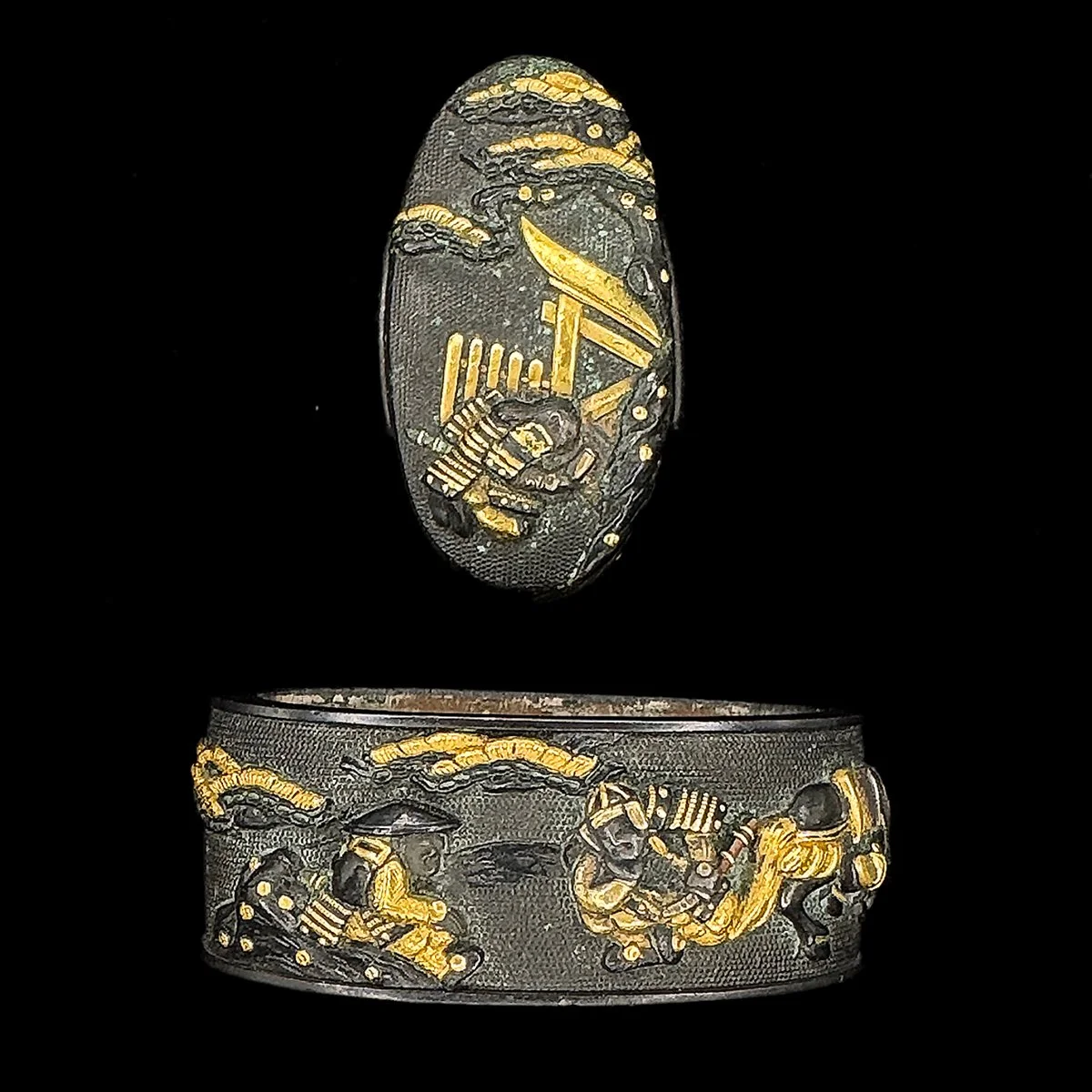Battle of Uji River Tsuba and Fuchi-kashira Set
Edo period (1615-1868)
Nanako Shakudo Tsuba and fuchi-kashira depicting the first Battle of Uji River
The tsuba is almost circular. It is shakudō with a nanako ground, and chiseled in relief with details in gold.
The tsuba shows the race across the Uji River.
The fuchi-kashira show samurai at a Shinto shrine
2 7/8in (7.3cm) high, the largest (3).
Story: The Race Across the Uji River (1180)
This tosogu has the depiction of a scene from the 14th-century military epic “The Tale of the Heike” (Heike monogatari). In the telling of this part of the story the Taira army were chasing a rebel army that had been raised by Prince Mochihito.
The two armies met at the site of a bridge across the Uji river. The following confrontation became known as the First Battle of Uji (1180).
The rebels stripped the bridge back to its bare bones (see the top left of the tsuba) forcing the armies to confront each other in an archery duel, which tended to favour the rebels as they had warrior monks on their side who used powerful bows that could penetrate the wooden shields used at the time.
The battle wore on until sunset with the broken bridge as a chokepoint leading to stalemate. As the sun set, a retainer on the Taira side suggested that they should try to ford the river or go around to find another route. The river was swollen by heavy rains, but Sasaki Takatsuna and Kajiwara Kagesue decided to lead a contingent of 300 samurai across the river to engage with the enemy on land.
The two of them rushed to get across the river first with Sasaki Takatsuna cheating a little by calling out to his rival that his mount’s saddle girth was loose, allowing him to ride ahead while Kajiwara Kagesue checked to see if his saddle was secure.
On the tsuba we can see the two Genji generals, Sasaki Takatsuna and Kajiwara Kagesue, riding through the water to get across the river. The position and depiction of Kajiwara Kagesue on the right is very closely mirrored by this diptych held by the Walters Art Museum. We can see Kajiwara Kagesue holding his bowstring in his mouth in the same way, and his horse is twisting to his left too.
Holding the bowstring in his mouth seems to be a common trait in depictions of Kajiwara Kagesue as he crosses the river.
The reverse of the tsuba has a group of three samurai on the opposite bank of the river, with the bridge in the upper right. They are presumably the opposing army, and seem to be gesturing to their enemies across the river.
It’s hard to say exactly what action from the story is being depicted on the fuchi-kashira. The kashira shows a samurai at a shrine which could be related to the fact that Prince Mochihito had stayed at the Mii-dera temple before moving his forces to Uji. The fuchi shows samurai (possibly the main characters) preparing or resting next to a tied up horse.
This battle seems to have been a popular moment of the story for depiction on tosogu and other art forms, with examples such as those above, and this kozuka in the MFA Boston (see here) also showing the beginning of the race across the river.
This screen held at the Met shows another view of the start of the race to cross the river, with the broken bridge in the background.
Sources:
https://www.metmuseum.org/art/collection/search/78537
https://art.thewalters.org/object/95.181/
https://en.wikipedia.org/wiki/Battle_of_Uji_(1180)
Provenance
Property from the Alan and Simone Hartman Collection (Bonhams March 2025)


